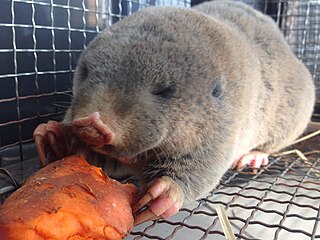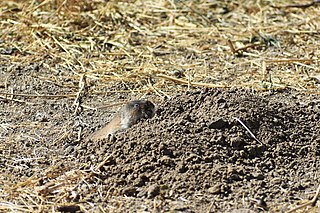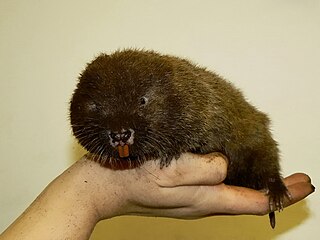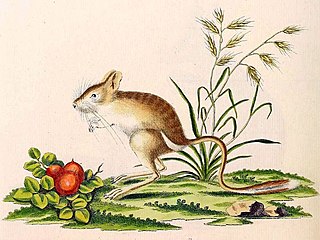
Zokors are Asiatic burrowing rodents resembling mole-rats. They include two genera: Myospalax and Eospalax. Zokors are native to much of China, Kazakhstan, and Siberian Russia.

The Spalacidae, or spalacids, are a family of rodents in the large and complex superfamily Muroidea. They are native to eastern Asia, the Horn of Africa, the Middle East, and southeastern Europe. It includes the blind mole-rats, bamboo rats, mole-rats, and zokors. This family represents the oldest split in the muroid superfamily, and comprises animals adapted to a subterranean way of life. These rodents were thought to have evolved adaptations to living underground independently until recent genetic studies demonstrated they form a monophyletic group. Members of the Spalacidae are often placed in the family Muridae along with all other members of the Muroidea.

The European ground squirrel, also known as the European souslik, is a species from the squirrel family, Sciuridae. It is among the few European species in the genus Spermophilus. Like all squirrels, it is a member of the rodent order. It is to be found in eastern Europe from southern Ukraine, to Asia Minor, Austria, the Czech Republic, Slovakia, Serbia, Greece, Romania, Bulgaria, North Macedonia and north as far as Poland but the range is divided in two parts by the Carpathian Mountains.

The Himalayan marmot is a marmot species that inhabits alpine grasslands throughout the Himalayas and on the Tibetan Plateau. It is IUCN Red Listed as Least Concern because of its wide range and possibly large population.

The Siberian weasel or kolonok is a medium-sized weasel native to Asia, where it is widely distributed and inhabits various forest habitats and open areas. It is therefore listed as Least Concern on the IUCN Red List.

The southeastern pocket gopher is a species of pocket gopher that is native to the southeastern United States. It occurs in Alabama, Georgia, and Florida, where it is the only pocket gopher.
The Kam dwarf hamster is a species of rodent in the family Cricetidae. It is found only in the mountains of western China where it inhabits grassland, shrubby marshes and steppes. Although it has a limited range, the International Union for Conservation of Nature has assessed its conservation status as being of "least concern".
The long-tailed dwarf hamster is a species of rodent in the family Cricetidae. It is found in China, Kazakhstan, Mongolia, and Russia.

The northern mole vole is a species of rodent in the family Cricetidae. It is distributed over large parts of Eastern Europe and Asia.

The Zaisan mole vole, or eastern mole vole, is a species of rodent in the family Cricetidae. It is found in central Asia.

Brandt's vole,, also known as the steppe vole, is a species of rodent in the family Cricetidae. It is found in China, Mongolia and Russia.
The Libyan jird is a species of rodent in the family Muridae. It is found in Mauritania, Morocco, Algeria, Tunisia, Libya, Egypt, Jordan, Syria, Saudi Arabia, Iran, Iraq, Afghanistan, Turkmenistan, Uzbekistan, Kazakhstan and Western China. Its natural habitats are subtropical or tropical dry shrubland, intermittent saline lakes, hot deserts, and rural gardens.

The midday jird, or midday gerbil, is a species of rodent in the family Muridae and native to sandy deserts in Afghanistan, China, Iran, Azerbaijan, Kazakhstan, Kyrgyzstan, Mongolia, Russia, Tajikistan, Turkmenistan, and Uzbekistan. How this rodent received its common name is unclear as it is mainly nocturnal.
Buxton's jird is a species of rodent in the family Muridae. It is found in the Negev desert and the northern coastal parts of the Sinai peninsula.
The Mediterranean pine vole is a species of rodent in the family Cricetidae. It is found in France, Andorra, Portugal, and Spain where it lives in a network of shallow tunnels.

The lesser bamboo rat is a species of rodent in the family Spalacidae. It is monotypic within the genus Cannomys. It is found in Bangladesh, Bhutan, Cambodia, China, India, Myanmar, Nepal, and Thailand.

The northern three-toed jerboa is a species of rodent in the family Dipodidae. It is monotypic within the genus Dipus. It ranges across Iran, Uzbekistan, Turkmenistan, Kazakhstan, Russia, China and Mongolia. A common species, the International Union for Conservation of Nature rates it as being of "least concern".
The Chinese jumping mouse is a species of rodent in the family Dipodidae. It is monotypic within the genus Eozapus. It is endemic to China where its natural habitat is temperate forests, steppes and meadows in mountainous regions. It is tolerant of some degree of habitat destruction, and the International Union for Conservation of Nature has assessed its conservation status as being of "least concern".
Merriam's pocket mouse is a species of rodent in the family Heteromyidae. It is found in northeast Mexico and New Mexico, Oklahoma and Texas in the United States. Its habitat is shortgrass prairie, desert areas with scrub and arid shrubland. The species is named to honor Clinton Hart Merriam, a biologist who first described several other members of the genus Perognathus, and first elucidated the principle of a "life zone" as a means of characterizing ecological areas with similar plant and animal communities.

Baird's pocket gopher or the Louisiana pocket gopher is a species of pocket gopher that is native to the southern United States. In total, there are three almost identical species of eastern pocket gopher; Geomys attwateri, G. bursarius, and G. breviceps. G. breviceps is larger in size, G. attwateri is medium-sized and G. bursarius is a bit smaller. Other than by size variation they are not identifiable by external features. Baird's pocket gophers are small rodents with most of their weight on the top half of their bodies.














